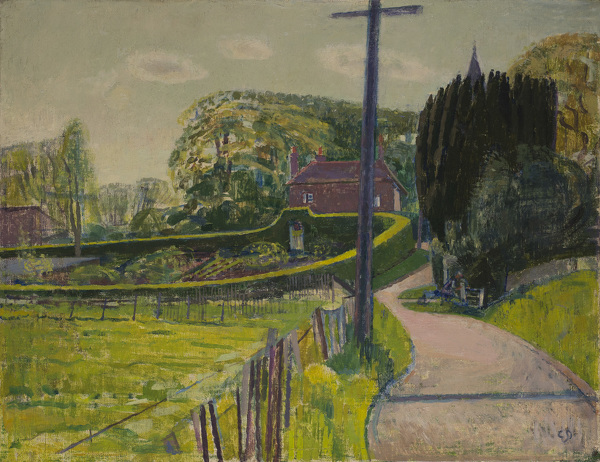
Hinxhill, c.1952 [HMO 768]
Framed (ref: 6322)
Tags: Evelyn Dunbar oil painted en plein air Dunbar catalogue

Tags: Evelyn Dunbar oil painted en plein air Dunbar catalogue
Provenance: Roger Folley; Alasdair Dunbar; Hammer Mill Oast Collection
Exhibited: Evelyn Dunbar - The Lost Works, Pallant House Gallery, October 2015 - February 2016 cat 32.
Literature: Evelyn Dunbar - The Lost Works, Sacha Llewellyn & Paul Liss, July 2015, cat. 32, page 78.
Hinxhill is a tiny hamlet east of Ashford, Kent, supposedly named after Hengist, the 5th century AD Teutonic invader of Kent. The artist and her husband Roger Folley moved near here late in 1950, following Folley’s appointment to the staff of Wye College. Signed ‘ED’, this is an early essay in the great series of Kentish landscapes that occupied Dunbar continually for the last 10 years of her life. As always, she finds a neat and organised vegetable garden irresistible.
"The kiss of the sun for pardon
The song of the birds for mirth,
One is nearer God’s heart in the garden
Than anywhere else on earth.
Dorothy Gurney (1858-1932)
Evelyn Dunbar clearly shared Dorothy Gurney’s vision and sentiments regarding
gardens. In one of Dunbar’s many letters to Mahoney she described how her ‘little patch
is beginning to form itself (with our help) into a lovely place, I think, and with all the
new things, will be a perfect heaven of varied greys and greens and aromatic odours.’
(September 1933). Painting and gardening were twin passions to her and in pursuit of
both she exercised a strong degree of control laying out her garden with the same care
and precision she exercised when laying out her palette.
Although born in Reading her formative years from the age of six, when the family
moved to Rochester, were spent in Kent, ‘the Garden of England’ as it is often described.
Gardens, hop-fields, orchards, the rich abundance of the Kentish landscape, is at the
core of her work. While others might be moved by the Highland landscape of Scotland
or the rugged beauty of the Alps, her heart remained firmly in ‘the Garden of England’.
Her identification with the homely man-made landscape of this corner of England was
as much spiritual as visual and needed to be assisted by the hard graft of hedging,
trenching, mulching, carting and pruning as well as celebrated in paint. One of her
earliest exhibited paintings was entitled Gardening, (present whereabouts unknown)
shown at the Goupil Gallery in 1931 and singled out by the critic of The Scotsman who
described it as ‘a most sensitive study of the Slade School type, of figures in a garden
delicately drawn and thoroughly “felt”.’ (The Scotsman, 11 June 1931) Such a description
could equally be applied to the study of The Dunbar Family in the Garden at the Cedars
(CAT 2 and 3), the Brockley sketch for The Woodcutter and the Bees (CAT 25) or even
the slightly later Land Workers at Strood (CAT 31) in the present exhibition. Her vision
was always that of a comfortable rural middle-class domesticity as far removed from
the peasant life that had inspired rural painters of the previous generation such as
George Clausen (1852-1944) and Edward Stott (1859-1918) as from the urban scenes
of Herkomer (1849-1914) or Mulready (1844-1904). Unlike her wartime paintings of the
Women’s Land Army the men and women – frequently members of her own family – who
inhabit these landscapes and work these gardens are at home and comfortable with
their surroundings.
Her acuity of observation is equally apparent in her landscape as in her figure subjects,
trees are individual not generic, their deformations lovingly recorded: the apple trees
growing in the orchard in the study of her mother gardening (CAT 27) are just as much
portraits as Sleeping Beauty (CAT 12) the ten minute sketch of her father. In contrast
to the immediacy of these oil sketches her large panoramic study of the landscape
at Hilly Fields (CAT 23) spread over three sheets of paper has the awesome grasp
of form that one associates more readily with eighteenth-century landscapists such
as Francis Towne (1739/40-1816) and the Italian Giovanni Battista Lusieri (1754-1821)
whose panoramas were so prized by the Grand Tourists. She had a countrywoman’s
eye for the nuances of landscape, of recession, cloud formations and weather which
informs her slightest studies and gives authority to her major works, most particularly
A Land Girl and the Bail Bull (FIG 19)."
Peyton Skipwith.